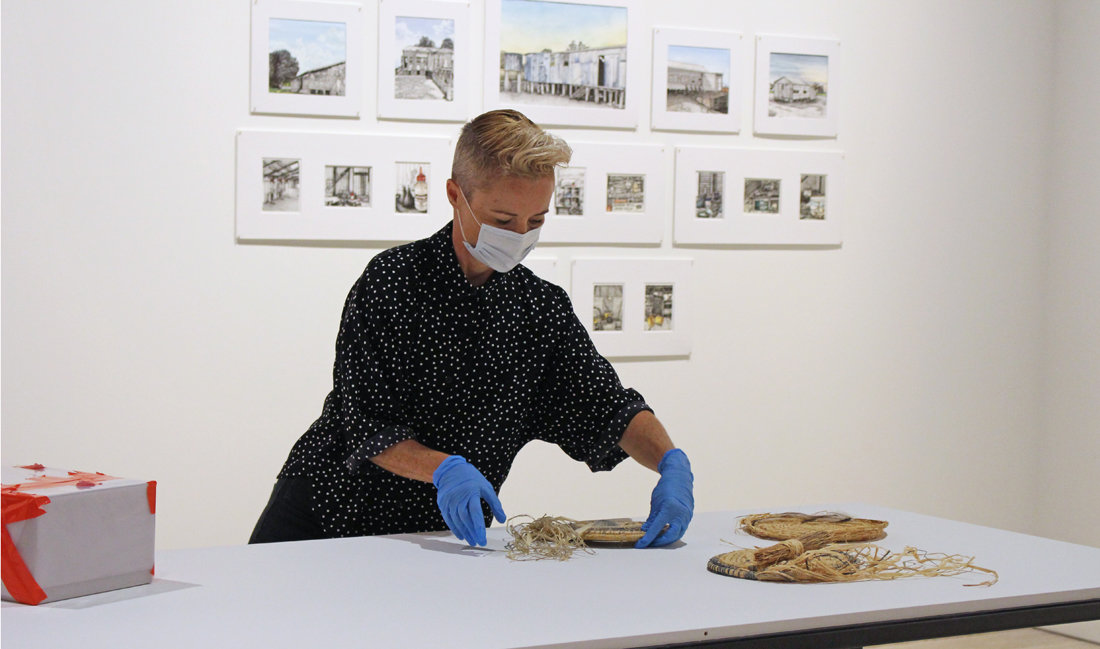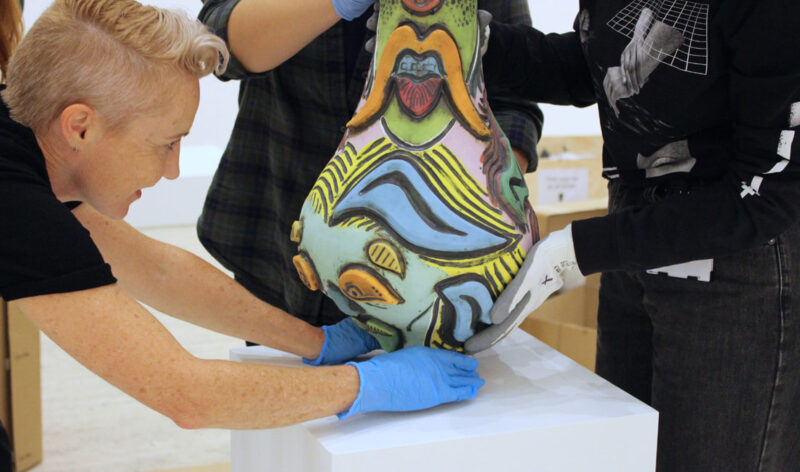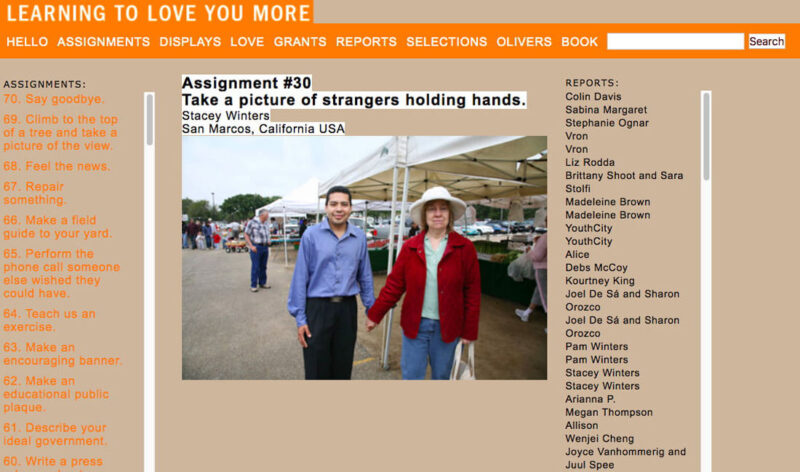
Foreground: Lisa Mansfield installing ngay dhawun, ‘my country, my land’, 2020, by Charlie Jackson (Brigidine College Randwick) for ARTEXPRESS. Background: Still, 2020, by Sarah Woolfe (Glen Innes High School) © AGNSW
What first attracted you to a career in conservation? How did you get started?
Art has always been part of my family. I did a BA in Visual Arts (installation/sculpture), my father worked as a draftsman and painted when he could, and my mother is a crafts person. Growing up, I often attended the Art Gallery of New South Wales (AGNSW), so those formative memories of art and creativity have always been part of my background.
I was transitioning from a 20-year career in design and publishing and searching for what to do next, wishing to work with interesting people, and I remembered meeting a museum conservator riffling through our skip when we moved from the Blue Mountains to Melbourne. She told me of her career and I wondered if she’d been living my dream life. Then I came across the conservation course at the Grimwade Centre, University of Melbourne, and made the switch!
In March 2020, I was fortunate to work with Asti Sherring, the then AGNSW Time-Based Art Conservator, for a two-week contract, and started as part of the Exhibitions Conservation team in December with France Cumming and Grace Barrand.
What does a typical work day look like at the moment?
There are many varied tasks and as yet no typical days! It may include several meetings, condition checking AV files or objects we receive as loans, creating reports, and devising display mounts in consultation with other conservators or the design team. On other days, I may check loaned works at deinstall to sign off on their condition for return to collectors, or discuss approaches to performance art documentation with conservator Rebecca Barnott-Clement. This week, I am working on the The National—an exhibition that presents current ideas and forms in contemporary Australian art, opening 26 March—which sees me working with contemporary artists, always a highlight!
Do you have a favourite object or collection that you have worked on?
At AGNSW, I was feeling pretty thrilled the day I was dusting a bronze sculpture by Louise Bourgeois for Archie Plus and then cleaning a work by Margel Hinder, a dynamic 20th-century sculptor, for her retrospective exhibition. Recently I worked on the ARTEXPRESS install, featuring extremely talented high school students who have created beautiful, thought-provoking works addressing important topics including climate change and cultural identity.

Lisa Mansfield installing Sideshow, 2020, by Emma Francis (Willoughby Girls High School) in ARTEXPRESS © AGNSW.
Another favourite was the deep dive research I was able to do for my university internship at the San Francisco Museum of Modern Art (SFMOMA). It really set the tone for my approach to time-based art conservation.
Can you think of an experience that has changed your perspective on conservation or how you approach your work?
Two experiences have been key to informing my approach to conservation. The Ngarranggarni: Gija Art and Country subject, which took place on-country at Warmun Art Centre and on surrounding Gija land in the East Kimberley, Western Australia. Taught by senior Gija knowledge holders as part of a collaborative two-way learning partnership with the University of Melbourne, this subject reinforced the ‘Nothing about us without us’ principle needed as a conservator. It taught to me ensure I am speaking with, not for, First Nation people when advocating for or working with their cultural heritage and that respect for different frameworks of reference is a vital part of conservation practice.
The other formative experience was my research project at SFMOMA, which is very proactive when it comes to collecting and conserving media art. They aren’t afraid to ask difficult questions and to take on complicated works – an incredible legacy for current and future audiences. As a result, SFMOMA owns a significant media art collection.
Researching the net art project Learning to Love You More (LTLYM) by Harrell Fletcher and Miranda July formed the case study of my minor thesis and highlighted the unique challenges faced by conservators due to the ever-changing web environment. Active between 2002 and 2009, over the project’s duration the online public were invited to submit ‘reports’ in response to 70 creative assignments devised by the artists. Each assignment featured quirky instructions like ‘Take a picture of your parents kissing’ or ‘Record the sound keeping you awake at night’. It allowed a glimpse into people’s lives across the world pre-social media, and encouraged people to leave their computers to interact with neighbours, strangers and their local environment. Today, the artwork exists both as a website and as an archive of digital and physical assets.

Learning to Love You More, 2002–2009, by Harrell Fletcher and Miranda July. ‘Assignment 30: Take a picture of strangers holding hands’ © SFMOMA.
SFMOMA modelled the importance of working collaboratively across departments in a respectful and productive way. I saw first-hand how essential open communication and teamwork are for effective conservation, with both colleagues and allied professionals. SFMOMA set the bar high, and informed how I wished to work. I learnt that there was no room for ego and to always ask questions no matter how insignificant they seemed to be!
Has working in conservation taught you any skills that you use in other areas of your everyday life? Or do you bring everyday skills into the conservation lab?
The holistic approach taught in the master’s program synthesises conservation ethics, cultural respect, materials treatment and teamwork. I use approaches learnt at university, at Warmun, and at SFMOMA every day.
What excited me at university was the mature age students’ breadth and diversity of experience that could inform conservation practices. Many had professional careers before pivoting to conservation, such as paint manufacture, education and teaching, project management, photography, database management, and advocacy. I find I bring skills into my workplace from my previous life as a magazine designer, which have been useful for grant applications, benefactor documents, and working on conference material for AICCM events.
What is the one thing you wish more people knew about conservation?
Constructive two-way partnerships/exchange is needed for the care of First Nations cultural heritage. Conservation ethics, respect for living cultures, and inclusivity are key to cultural collection care – as outlined and demonstrated in AMAGAs Indigenous Roadmap and projects by the University of Melbourne in conjunction with the Gija community (as one example). Australian conservators are in a unique position to advocate for the care of Indigenous cultural heritage to government, to the public, and with conservators internationally to assist with the decolonisation process of museum collections.
Anything else you might like to reflect on and share?
I would like to say a hearty thank you to the conservation community, and to AICCM members in particular, for welcoming, training and supporting me and my emerging conservator colleagues. From informal coffee chats and ‘speed dating’ at conferences, to mentoring programs, internships and that initial on-the-job training. Your generosity, kindness and hard work is greatly appreciated (more than you know) as we move into the profession.